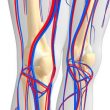Tratamiento de la isquemia crítica del miembro inferior . León Valdivieso
Técnica para el Tratamiento Endoluminal de la Isquemia Crítica de Miembros Inferiores
José L. Assad Morell2012-08-07 DirectorDivisión de Estudios CardiopulmonaresHospital Christus MuguerzaUniversidad de MonterreyMonterrey, México
Isquemia crítica de miembros inferiores. Cuadro clínico e indicadores de viabilidad
Guering Eid-Lidt2012-08-07 Departamento de Cardiología IntervencionistaInstituto Nacional de Cardiología “Ignacio Chávez”México DF
BASIL-2: Revascularization of Infra-Popliteal Territory in Patients with Critical Lower Limb Ischemia
Results of infrapopliteal territory revascularization in critical limb ischemia. Compared against the general population, patients suffering from critical lower limb ischemia (CLI) not only experience seriously limited quality of life, but also face a significant higher risk of death and amputation. Specifically, the optimal treatment for these patients remains uncertain. This uncertainty was sparked by<a href="https://solaci.org/en/2023/06/22/basil-2-revascularization-of-infra-popliteal-territory-in-patients-with-critical-lower-limb-ischemia/" title="Read more" >...</a>
Deep Vein Arterialization: Have We Conquered “Non-Revascularizable” Critical Limb Ischemia?
Deep vein Arterialization in patients with critical “non-revascularizable” limb ischemia. We are familiar with the poor quality of life and elevated mortality of patients with chronic limb-threatening ischemia (CLTI). In its last stages (nearly terminal), revascularization (either surgical or endovascular) has been shown to reduce amputation incidence. However, similarly to heart disease and other vascular scenarios,<a href="https://solaci.org/en/2023/04/03/deep-vein-arterialization-have-we-conquered-non-revascularizable-critical-limb-ischemia/" title="Read more" >...</a>
BEST-CLI: Revascularization of Critical Lower Limb Ischemia, a Pragmatic Study
Critical lower limb ischemia (CLLI) is associated with a major deterioration in quality of life and a significant increase in morbidity and mortality. Its estimated annual incidence is 220 to 3500 cases per million people, with an expected prevalence of 11% of patients with peripheral arterial disease. CLLI is the “terminal” stage of peripheral artery<a href="https://solaci.org/en/2022/11/22/best-cli-revascularization-of-critical-lower-limb-ischemia-a-pragmatic-study/" title="Read more" >...</a>
Drug-Coated Balloons in Critical Ischemia: The Paradigm of Randomized Evidence vs. Logbooks
This research, which included thousands of patients treated for chronic inferior limb ischemia with drug-coated balloons, did not show an association between said devices and the increased mortality observed in some randomized trials. The long-term evidence from plenty of real-world patients contradicts what has been shown in randomized trials, leaving an information gap. Endovascular revascularization<a href="https://solaci.org/en/2020/10/13/drug-coated-balloons-in-critical-ischemia-the-paradigm-of-randomized-evidence-vs-logbooks/" title="Read more" >...</a>
Frailty: What Happens When We Are Too Late in Critical Lower Limb Ischemia
This condition, now “trending” among patients undergoing transcatheter aortic valve replacement (TAVR), has expanded to almost all patients we treat, always with the same outcome: the prognosis is bad, so bad that it might warrant making the difficult decision of not going forward. The association between frailty and bad prognosis is easy to see and<a href="https://solaci.org/en/2018/09/11/frailty-what-happens-when-we-are-too-late-in-critical-lower-limb-ischemia/" title="Read more" >...</a>
Frailty and Critical Limb ischemia: Facing a New Challenge
Courtesy of Dr. Carlos Fava. Critical limb ischemia is the final stage of peripheral vascular disease and is associated to pain at rest, trophic lesions, and gangrene. It is also associated to amputation and reduced mobility. When it happens in frail patients, it presents a challenge. This population is on the rise and there is<a href="https://solaci.org/en/2018/08/27/frailty-and-critical-limb-ischemia-facing-a-new-challenge/" title="Read more" >...</a>
What Is the Prognosis for Reinterventions in Critical Lower Limb Ischemia?
Infrapopliteal (below the knee, BTK) percutaneous transluminal angioplasty (PTA) has been acknowledged as a useful strategy in chronic critical limb ischemia (CLI), but artery calcification severity results in considerable restenosis. Repeat PTA and the management of trophic lesions help with wound healing. However, this conduct has not been extensively assessed. This study enrolled 152 patients (175 limbs)<a href="https://solaci.org/en/2018/03/14/what-is-the-prognosis-for-reinterventions-in-critical-lower-limb-ischemia/" title="Read more" >...</a>






